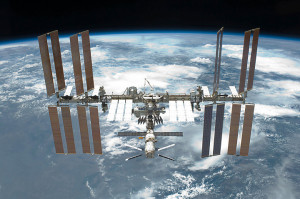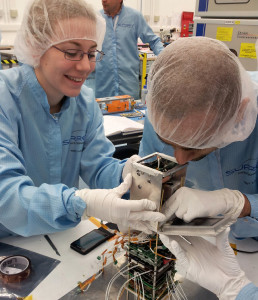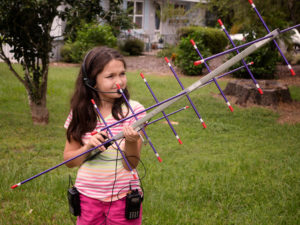Space & satellites

The ISS has regular amateur radio contacts between licensed astronauts and schools facilitated by ARISS
Amateurs have a long track record at the forefront of space activities, including moonbounce (EME) since 1953, satellites since 1961, licensed astronauts since 1983 and interplanetary missions since 2010.
Starting with OSCAR-1* in 1961, amateur satellites have been an innovative and inspiring feature of the hobby for many years.
In fact the Amateur Satellite Service is fully recognised as a distinct ITU service from its terrestrial cousin, and has its own specific frequency allocations in amateur radio license schedules. Many countries have amateur satellite groups – such as AMSAT-NA in the USA and AMSAT-UK here.
Amateur satellites operate primarily in the amateur bands from 21 MHz to 10 GHz. They can be used to provide communications using SSB, FM or digital modes over long distances at VHF and UHF. Using the Moon as a passive reflector for EME also exploits VHF/UHF and higher frequencies that can be transmitted through the ionosphere.

STRaND-1, a 3U Cubesat
Radio amateurs played a key role in the development of low-cost small-satellite CubeSat technology. Amateur innovations in this field have subsequently been picked up by a fast-growing commercial space sector.
The vast majority are launched into Low Earth Orbit (LEO) where their relative speed as they traverse the sky requires attention to antennas and Doppler frequency correction as well orbital and timing information.
More recently, 2018 saw the launch of the first geostationary satellite carrying an amateur payload. QO-100 provides 24 hour continuous coverage for amateurs from Brazil to Thailand and from the Arctic down to Antarctica using High Definition Digital TV, SSB and Data Modes. AMSAT-UK and BATC have made available a web-based SDR receiver located at Goonhilly to enable you to listen to the QO-100 downlink online.

Keen amateur satellite operator, Hope KM4IPF
The International Space Station (ISS) has onboard equipment for amateur radio voice, data and TV. ARISS† coordinate schools contacts with astronauts, which are especially popular. Periodically, amateur Slow Scan Television (SSTV) pictures are transmitted and can be received using just a 145 MHz handheld radio. The ISS can also act as a launch platform for small satellites.
Most astronauts on the ISS are licensed amateurs and during their spare time may talk to other radio amateurs back on Earth. There is a special thrill in talking to an astronaut or receiving a picture sent from space!
Further reading
- Amateur Satellites – Getting Started – RadCom, March 2007
- The Easy-100 – uplink converter for QO-100 – RadCom, June 2019
AMSAT-UK beginners’ links
- How do I start ?
- How to hear the ISS
- How to track satellites
- How to receive ISS SSTV
- VHF WebSDR for ISS and FUNcube satellites
- QO-100 information
- QO-100 WebSDR
Click here for the latest amateur satellite status.
*OSCAR – Orbiting Satellite Carrying Amateur Radio
†ARISS – Amateur Radio on the International Space Station










